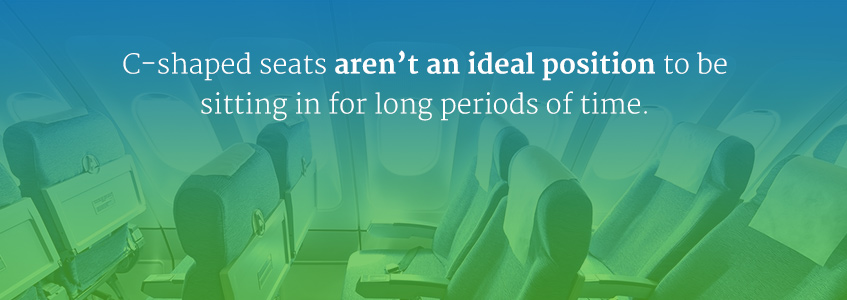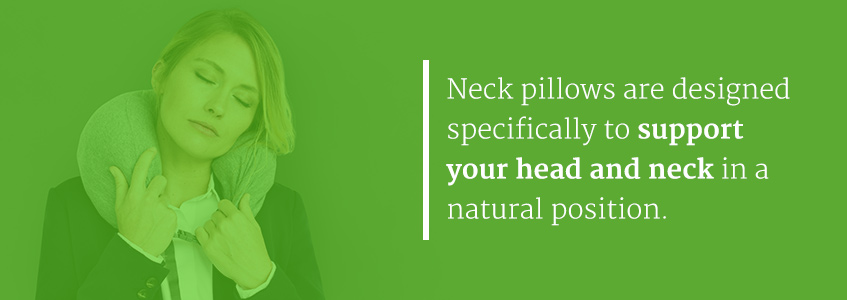Whether you’re flying with a pre-existing condition causing your neck pain or you start feeling back pain after a flight, you should understand how a several-hours flight can impact your spine. If you’re already a frequent flier or taking your first overseas flight, you have more options to prevent or alleviate back and neck pain other than reclining your seat.
About Back and Neck Pain
You can experience back and neck pain in many forms, including:
- Dull
- Mild
- Severe
- Persistent
- Annoying ache
- Disabling
Both neck and back pain can be acute, meaning it comes on intensely and suddenly. Chronic neck or back pain can last anywhere from weeks to months — even years. The pain you experience may be intermittent or continuous.
Back pain can interfere with your quality of life and normal functioning. It can also restrict mobility. About eight out of 10 of us experience back pain at some point in our lives.
You get neck pain in the cervical vertebrae area of your neck. Because of its range of motion and location, it can leave your neck unprotected and susceptible to injury. Neck pain is common too, particularly in people over the age of 50.
Top Reasons Why Flying Can Hurt Your Back or Neck
Factors potentially aggravating neck and back pain while traveling include:
- Experiencing traveling stress
- Sitting or standing for too long in an awkward position
- Sleeping in an unnatural position
- Continually lifting heavy items, like a suitcase
- Sitting in uncomfortable seats
Flying on an airplane can expose you to all these activities.
Seats on Airplanes
Many individuals find both economy class and coach airplane seats uncomfortable. In a SpineUniverse 2008 study, researchers surveyed people regarding airplane seats and how they affect the travelers’ necks and backs.
On all discount and major airlines, the fliers claimed all economy class and coach airline seats are uncomfortable. Of particular note, respondents claimed the seats on AirTran were the worst regarding comfort. Out of all the survey takers who traveled with AirTran for their flight, 95 percent claimed their seats were very uncomfortable.
United Airlines, American Airlines and Jet Blue didn’t fare well either, receiving uncomfortable seat ratings of 67 percent, 70 percent and 86 percent, respectively.
Southwest received the “best” rating, but it still came in at a 52 percent of travelers claiming uncomfortable seats.
C-Shaped Airplane Seats
When airlines chose the coach or economy C-shaped seats, they weren’t particularly thinking about their travelers’ comfort. Instead, key factors in the design of seats involve maximizing the number of travelers in the airplane at one time, along with safety. Back pain due to traveling in an airplane in these types of seats is common due to the lack of support the seats offer for the human body. Healthy individuals coming off of a long flight end up complaining about achy necks, backs and legs.
The C-shaped seats aren’t an ideal position to be sitting in for long periods of time. They “offer no lumbar support,” according to professor of Design & Environmental Analysis at Cornell University, Alan Hedge Ph.D., CPE. They also push your head and neck forward, adding to your discomfort. Slouching in an airplane seat also accentuates the unnatural C-shaped sitting position. To maintain proper posture, you should keep your spine in the neutral S-shaped position.
Limited Space of Airplane Seats
A considerable imposition through many methods of travel is the limited space making it difficult for you to switch positions. It also reduces recovery of your fatigued postural muscles and increases the load on your spine. Traveling for several hours can cause substantial lumbar spine pressure and associated pain.
Also, when you’re stuck in an airplane seat, it shortens your:
- Hamstrings
- Hip flexors
- Lower back muscles
- Hip muscles (glutes and quads)
After “being shortened” for an extended period, your muscles become tight upon standing. Not to mention, because you were bending your legs for the whole trip, your blood wasn’t circulating properly and wasn’t nourishing your muscles, and this can also result in pain.
Tips to Relieve Neck and Back Pain While Traveling
Your spine was not designed to sit in an airplane for hours on end — it was designed to move. Fortunately, when you can’t avoid those long plane trips, you can incorporate tips for flying with back or neck pain — before, during and after your flight — to help prevent or relieve back or neck pain from flying.
Before the Flight
Some steps you can take before you board a long flight are:
1. Request help from your doctor. When you’re planning out your trip, your doctor can be your best advocate for making your flight as comfortable as possible. If you have a chronic back or neck condition, consider asking your doctor if they can provide you with a letter you can give the flight crew and airline to persuade them to provide you with special accommodations.
For instance, a letter from your physician could get you things such as:
- Extra cushions and blankets
- The ability to walk around during your flight
- The ability to lie down on the airplane floor and rest
- An upgrade to business class
2. Contact the airline. In addition to obtaining a letter from your doctor, you’ll also want to contact the airline you’ll be flying with ahead of time and let them know about your medical condition, if you have one. Often with notice, airlines may:
- Offer you early boarding, wheelchair assistance or other medical attention
- Accommodate you with elevator platforms and special shuttles for boarding
- Have personnel lift your luggage into the overhead bin or carry it around for you
- Allow another person (non-medical) to assist you through security and when you board the plane
3. Schedule smart. To avoid neck and lower back pain airplane travel problems, you may want to book a flight during a time of day where there are fewer chances of it being full of passengers. This will make it simpler for you to move around regularly, stand up and stretch or change up your sitting position when necessary.
4. Pack your suitcases light. Each item you put into your suitcase adds more weight to what you’ll be dragging around the airport and lifting into the overhead bin. Pack fewer items to make it simpler on yourself and, if possible, check your bags in so you won’t have to lift them into the overhead bin. Don’t be shy about asking the flight crew to help you hoist your carry-on bag into the overhead bin.
5. Pack medications. If you’re used to flying with back pain, you may want to pack some acetaminophen or ibuprofen before your flight to help prevent inflammation and pain. Be sure to pack other medications you require that can make you more comfortable.
6. Exercise. Keep on top of your exercise regimen, particularly a couple of weeks before your trip. If you haven’t worked out for a long period, it could cause your back muscles to spasm after sitting in tight quarters all scrunched up. Maintain your workout routine to keep your muscles flexible and nimble before your flight.
During the Flight
Some things you can do during your flight to reduce back and neck pain or your chances of experiencing it are as follows:
1. Get up and move. If you’re not a person who can sleep through an entire plane trip, see if you can’t book yourself an aisle seat on the airplane. By sitting in an aisle seat, you are free to move around and stand up regularly with disrupting the passengers sitting next to you. It can also help you avoid the pain and stiffness that tend to accompany sitting in the same position for extended periods. Without getting in the flight attendants’ way, you may be able to go to the back of the plane and do some simple stretches.
2. Apply cold or heat therapy. Apply heat therapy when you first get into your seat to help minimize stiffness and loosen your muscles. Then switch to cold therapy once you’ve been sitting for a few hours to help cool inflammation and pain excessive sitting causes.
3. Recline your seat. Sitting down places a lot of stress on your discs, whether seated on a C-shaped airplane seat or not. Reclining your airplane seat enables you to support the weight of your body into the backrest, rather than on your spine. When you recline your seat, it decreases the gravity and pressure of your body weight on your spine.
4. Use neck pillows and back support accessories. You may need to experiment with various cervical travel pillows or back support accessories to find what works best for you.
- Neck pillows
While research on neck pillows is thin, some studies have shown neck pillows with good shape and firm support can help reduce morning neck pain better than a regular pillow. A study with 128 chronic neck pain patients showed when they combined a physical therapist-administered exercise treatment along with using a supportive neck pillow, it relieved their chronic neck pain better than exercise alone.
Neck pillows are designed specifically to support your head and neck in a natural position. They’re all made to provide your head with a natural resting position that maintains your spinal lordotic curve.
You’ll find various neck pillows on the market to help provide you with a good night’s sleep and reduce your neck pain. The pillows made of small beads or foam work better than the inflatable ones that don’t contour your neck shape naturally or support your neck as much. However, you can customize inflatable or water-filled neck pillows for support and firmness tailored to your needs and preferences.
Some recommended neck pillows you can try include:
- BCOZZY Chin Supporting Travel Pillow
- Trtl Pillow
- Travelmate Memory Foam
- Homesky
- Travelrest – Ultimate Travel Pillow
- Airplane Pillow by Royal Limits
Each has their own unique qualities and design. Your cervical travel pillow should also provide big enough lateral cushioning for supporting your neck while you’re sleeping and preventing excessive side bending.
- Back support accessories
Back lumbar rolls, seat pans and posture coaching wearable devices can offer a short-term solution to provide extra spinal support. While sitting in the airline seat, place a pillow between the back of your seat and your lower back to provide travel back support and minimize the amount of strain on your neck and back. By doing this, you’ll keep yourself from slouching and preserve your natural lumbar curve, reducing your chances of back spasms.
Lumbar rolls should also be large enough so they will support your low back or the natural lordotic curve of your neck. But, you don’t want them too large where the roll will push your whole body away from your seat. If you don’t have a lumbar pillow, you can roll up a sweater to place in your lower back area for support.
Back braces may work well too. To maximize how effective your back brace is, stand up and look straight ahead when applying the brace. This avoids bracing your spine in flexion and maintains your lumbopelvic neutral.
5. Watch your posture. Along with sitting correctly, watch your posture as well. If you’re not positioning your legs at a right angle while sitting down in your seat, request something — such as a blanket or pillow — to maintain a right angle with your knees and prop your feet up. By doing this, you’ll keep stress off your lower back. Ask for a bulkhead seat or an exit row if you have long legs since they both will provide you with more leg room.
6. Engage your mind. Some say specific imagery techniques may help you decrease your neck and lower back pain experience while you’re flying in an airplane. Mental anesthesia is one easy technique for you to try. With this technique, you’re simply picturing a numbing anesthetic shot injection into your lower back. You could also try cooling and soothing ice pack imagery you’re placing on your lower back.
7. Stay hydrated. Hydration is important all around. However, keeping yourself hydrated a few days before you travel can help reduce your pain. When you’re dehydrated in a dry airplane cabin, it can make back problems and joint stiffness worse. When your spinal discs’ inner gel becomes dehydrated, they become more susceptible to stress, increasing their risk of a tear or bulging. Therefore, begin drinking water a few days before your flight and during your flight.
After the Flight
If you’re suffering from neck or back pain after your flight, it’s not too late. There are steps you can take to ease the pain. These include for you to:
1. Try yoga. An Archives of Internal Medicine published study showed yoga helps relieve lower back pain.
Another study published in the Annals of Internal Medicine showed taking yoga classes was more effective than a regular back function-improving care routine, meaning back-related issues didn’t interfere with daily activities like:
- Standing
- Walking
- Climbing stairs
2. Keep moving. If you’re in pain after your flight, keep moving. Don’t stay seated for extended time periods. Also, stretch your back out using the spinal roll-down. You can also relax tense muscles and iron out stiffness with a deep-tissue massage.
3. Sleep smart. The way you position yourself while sleeping can affect the health of your back. The night you arrive at your destination, try to sleep in a relaxed fetal position on your side with your knees bent. Use a small pillow and place it under your neck which will help keep your spine in alignment. You can place another pillow between your legs to help keep your top leg from moving forward which can twist your lower back while you’re sleeping.
See a Pain Specialist If Your Pain Persists or Becomes Chronic
Pain is complex, and numerous treatment options are available to you in the form of therapies, medications and mind-body techniques. If your pain persists after you return from your trip, see a back pain specialist who can provide you with a long-term solution. Contact us here at the Spine INA if you have chronic neck or back pain.














I had bad back surgery and turned out to be a nightmare. Now my spine is 10mm slipped off my pelvic bone and my spine is detached in multiple places. I’m in need of a very intense 8 hour long surgery. Can I fly before this? At the same time the rod in my neck isn’t stable anymore and causes me migraines. I did fly one time without knowing in 2015 and had migraines so bad with vomiting for more than a week. I had just thought I got sick in Florida. I’m thinking it’s not in my best interest to fly yet want to see my grandkids. Any ideas?
Hi Debra! We would love to speak about this with you. Please give us a call or fill out a contact form and we will be in touch!
I don’t know the pilot’s constraints but when I travelled from Chennai to Delhi in July 2019, recovering from disc prolapses in the cervical region, the landing in Delhi was so hard that, for a moment, I thought my neck is broken and I am finished!
V.Ramesh
Delhi
So sorry to hear about that pain! We understand that completely. If you have any questions or anything we could help out with, feel free to give us a call!
Hi,
I’m scheduled to have my Halo ( Car accident 1/1/20-C2&c3 fractures) removed March27th and replaced with an Aspen collar. The c3 has healed fine, but the c2 not completely healed. I live in NY and have a family event to attend in California (plane ticket purchased before accident). Can I fly with the aspen collar?
Hi Debra! Great question – please give us a call and we can do our best to assess the situation via phone!
Walk around as much as possible on the plane. Stretch and try to do yoga before getting on the plane.
Also Google towel back stretches. You can do these in the aisle with just a towel. Nevermind the funny looks you’ll get, you’ll feel much better.
Great tips!!